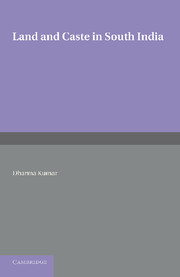 Land and Caste in South India
Land and Caste in South India Book contents
- Frontmatter
- Dedication
- CONTENTS
- List of Tables and Figures
- Acknowledgements and A Note on Certain Connventions
- Abbreviations
- Map of the Madras Presidency
- PART I
- I INTRODUCTION
- II THE AGRARIAN BACKGROUND
- III FORMS OF AGRESTIC SERVITUDE
- IV THE IMPORTANCE OF AGRICULTURAL LABOUR IN THE FIRST HALF OF THE NINETEENTH CENTURY
- V OFFICIAL POLICY AND THE EMANCIPATION OF THE AGRICULTURAL LABOURER
- VI OFFICIAL POLICY: LAND TENURES AND LAND REVENUE
- PART II
- Glossary
- Bibliography
- Index
VI - OFFICIAL POLICY: LAND TENURES AND LAND REVENUE
from PART I
Published online by Cambridge University Press: 05 June 2016
- Frontmatter
- Dedication
- CONTENTS
- List of Tables and Figures
- Acknowledgements and A Note on Certain Connventions
- Abbreviations
- Map of the Madras Presidency
- PART I
- I INTRODUCTION
- II THE AGRARIAN BACKGROUND
- III FORMS OF AGRESTIC SERVITUDE
- IV THE IMPORTANCE OF AGRICULTURAL LABOUR IN THE FIRST HALF OF THE NINETEENTH CENTURY
- V OFFICIAL POLICY AND THE EMANCIPATION OF THE AGRICULTURAL LABOURER
- VI OFFICIAL POLICY: LAND TENURES AND LAND REVENUE
- PART II
- Glossary
- Bibliography
- Index
Summary
The chief administrative and legal levers for bringing about social changes lay not in the reform of ‘slavery’ but in land policy; and this was abundantly clear to the officials of the time. The point is obvious enough, since India was a largely agricultural society, and since it was from the taxation of land or its products that the Government derived the major portion of its revenue. Indeed revenue was the first concern of the British regime. So overstretched were the finances of the East India Company at the end of the eighteenth century that it was only the profits of the China trade which covered their Indian costs. In the early nineteenth century these costs increased as the Company's territory spread, so that in this period the land revenue was often set at high, almost penal, rates. In South India the British had only to follow the example of their immediate predecessors: Tipu Sultan, for example, collected well over 50 per cent of the gross produce of the soil by way of land revenue and various other taxes.
Apart from this helpful precedent, their predecessors bequeathed the British a host of problems. The political confusions of the eighteenth century had led to a breakdown of the revenue administration: the village registers were in chaos, with unauthorized ‘renters’ collecting a mass of illegal imposts, and having assumed various rights of ownership. There were few written records of rights to guide the new administrators. And custom was an equally unreliable guide. There were several claimants to the land, ranging from feudal chieftains, through tax collectors, to actual cultivators, each invoking the authority of custom. To begin with, the policy of the new government tended to allow lands to become private property. But who should be proprietor? Four main types of superior tenure-holder confronted them: in the Telugu and some of the Tamil areas, the zamindar; in the Telugu and Tamil areas, the inamdar; in the Tamil areas, the mirasdar; and in Malabar and South Canara, the janmi and mulwargadar.Recognizing such men as proprietors was only the first step; did they, or did they not, possess the rights which in English land law would accompany ownership in fee-simple? What should be their relationship with the other occupants, if any, of their lands? And at what rates should they be assessed to tax?
- Type
- Chapter
- Information
- Land and Caste in South IndiaAgricultural Labour in the Madras Presidency during the Nineteenth Century, pp. 77 - 98Publisher: Cambridge University PressPrint publication year: 2013


